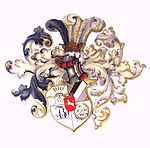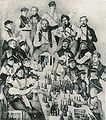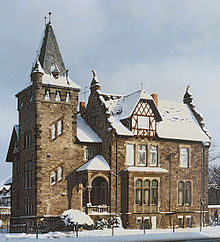Corps Brunsviga Göttingen
| coat of arms | ||||||
|---|---|---|---|---|---|---|

|
||||||
| Basic data | ||||||
| country | Lower Saxony | |||||
| university | Georg-August-University Goettingen | |||||
| Foundation date | August 11, 1813 | |||||
| Umbrella organization | KSCV | |||||
| Seniors' Convent | Goettingen Seniors' Convention | |||||
| Motto | Fortiter adversis opponite pectora rebus! | |||||
| Colours |
|
|||||
| Circle | ||||||
| address | Bürgerstrasse 31 37073 Göttingen |
|||||
| Homepage | www.corps-brunsviga.de | |||||
The Corps Brunsviga Göttingen is a corps ( student association ) in the Kösener Senioren-Convents-Verband (KSCV), the oldest umbrella organization of German student associations. The corps is obligatory and colored . It unites students and former students of the Georg-August-Universität Göttingen .
The corps members are called "Göttinger Braunschweiger" or - with reference to the color of the hat - "Black Braunschweiger".
Color
Brunsviga has the colors "black-white-light blue" with silver percussion. For this purpose, the active and inactive wear a small black cap ("occipital color") ( see also: student cap ); Old men wear a hat in a larger format.
As with all Göttingen Corps, the foxes at Brunsviga do not wear a fox ribbon. The fox hat also has a white cord on the upper edge , in the case of conspirators this cord is silver.
The motto is “Fortiter adversis opponite pectora rebus!” (Quote from Horace : “Always hold a strong chest against misfortune!”).
prehistory
FL v. Münchhausen, senior of the Braunschweigische Landsmannschaft 1778 and member of the Order ZN ( Schubert Silhouettes Collection )
Duke Friedrich Wilhelm von Braunschweig-Oels ("Black Duke"), painted in 1809
In the course of the 18th century, there were regional associations of Braunschweig students in Göttingen. With drawings from 1773, the Rupstein register kept in Göttingen shows the student uniform of a member of the Braunschweiger Landsmannschaft at that time in comparison to that of the other existing Landsmannschaft. With the colors white and blue, this uniform anticipates the later corps colors.
history
Scale length 1847: v. Korff (left), Corps Brunsviga, and Meyer, Corps Saxonia
The corps was founded under the name "Brunsvigia" on August 11, 1813 by students from the Duchy of Braunschweig-Lüneburg and the Diocese of Halberstadt . So far the students from the Duchy of Braunschweig-Lüneburg and the Diocese of Halberstadt had been members of a "Hassonia" together with the Hessian students. But when the former state university of the Principality of Braunschweig-Wolfenbüttel , the University of Helmstedt , was closed in 1810 , more Braunschweig and semi-urban students came to Göttingen, the traditional Hanoverian state university. The need for a special Brunswick country team increased. The first surviving Constitution des Corps dates from February 18, 1814.
The colors were initially “black-blue-red”, with the black and blue being derived from the uniform colors of the “ black crowd ” of Duke Friedrich Wilhelm von Braunschweig-Oels (“Black Duke”), while the red came from the colors of the diocese Halberstadt (white-red). Further color changes followed (black-blue, black-blue-white), and since 1828 Brunsviga has been wearing "black-white-light blue".
The Brunswick students expressed their enthusiasm for their Duke through the choice of colors, who had secured the independence of the Duchy of Brunswick during the Wars of Liberation. The fact that the duke lost his life in the battle of Quatre-Bras , a few days before the battle of Waterloo , contributed to the creation of the legend ( see also: The Black Brunswicker ).
In the course of the 19th century, at least four ministers of state (corresponding to today's Prime Minister ) and other important politicians of the Duchy and the city of Braunschweig emerged from the circle of members of the Corps . This shows the strong country team orientation of the Corps on the Braunschweig region and the great attraction to leading circles of the Duchy, but also of the later Free State of Braunschweig .
Brunsviga has been a member of the Kösener Seniors Convents Association (KSCV) since the association was founded in 1848 . In 1855 it established the first regular suburb . In the 1860s, Brunsviga and his cartel corps Corps Thuringia Jena ("Jenenser Thuringians") formed the core of the " Black Circle ", the oldest circle within the KSCV. The name "Black Circle" was derived from the hat color of the Brunswick and Thuringians. Further circle foundations with different color names followed.
Brunsviga has been linked to Thuringia since 1846 through a "cartel". This is the oldest unbroken cartel in the KSCV and thus probably also the oldest uninterrupted relationship of student associations in the German-speaking area. Brunsviga and Thuringia, together with Corps Hassia-Gießen zu Mainz and Corps Suevia Munich, have formed the "Eisenacher Cartel" since 1909, which is considered the core of the "Black Circle" in the KSCV.
In the second half of the 20th century, Brunsviga Göttingen took over two corps that were rooted in the military medical Kaiser-Wilhelms-Akademie for military medical education : in 1956 they merged with the Corps Saxonia Hann. Münden, took in its members and committed to continue their tradition. A similar contract was signed in 1979 with the Corps Franconia Hamburg .
Corp house
At the foundation festival in the summer of 1894, the corps made the decision in principle to build a corp house. The first suggestions for this came from the year 1890. Most Göttingen corps already had corps houses or were planning to build them. Another important reason was that the corps members no longer liked the traditional traffic bar Deutscher Garten, also called "on the Kaiser" after its host. There the "annoying neighborhood of non-colored connections" had to be endured.
In the summer of 1896, the funds raised were used to buy a plot of land near the Bismarckhäuschen , directly outside the old city wall in the south of the city, today Bürgerstr. 31. At the 75th foundation festival in the summer of 1899, the foundation stone of the Corphaus was laid in the presence of 150 participants. Immediately after the event, construction began under the direction and according to plans of the architect Wilhelm Rathkamp in the neo-renaissance style. The construction company Conrad Rathkamp & Sons (Göttingen) took over the execution. Three old men from the Corps formed the building committee.
On November 25, 1899, the topping-out ceremony for the Corphaus was celebrated on a small scale. After the closing ceremonies of the summer semester, the corp house was opened on August 4, 1900. The corps servant Kastner moved with his family into the basement apartment intended for him. During the holidays, the finishing touches were put on the interior design. The actual move into the corp house took place at the beginning of the winter semester 1900/1901. The house became more and more the center of the whole corps life.
The building stands in the former city moat and rests on foundations made of limestone rubble averaging 4.75 meters high. The masonry above the base cornice consists of tuff stone with corner blocks and architectural parts made of red sandstone. The half-timbered house facing the street. The building is dominated on its southwest corner by the somewhat offset stair tower with a slipped hood. In addition to the pub room and the two-storey ballroom, the ground floor accommodated a convent room and various function rooms. On the upper floor there are rooms for the members of the corps.
Conditions
The Corps Brunsviga has established numerous relationships with corps at other universities since the 19th century - mainly through the mediation of joint members.
Cartels
- Corps Thuringia Jena (cartel since 1846)
- Corps Suevia Munich (cartel since 1888, friends since 1868)
- Corps Hassia-Gießen zu Mainz (cartel since 1892, friends since 1868)
- Corps Franconia Tübingen (cartel since 1920, friends since 1876)
Friendly relationships
- Corps Borussia Greifswald (friends since 1879)
- Corps Hansea Königsberg (friends since 1897, relationship since 1889)
- Corps Suevia-Straßburg zu Marburg (friends since 1919, relationship since 1878)
- Corps Suevia Freiburg (friends since 1919, relationship since 1889)
- Corps Bavaria Würzburg (friends since 1924, relationship since 1912)
- Corps Gothia Innsbruck (friends since 1995, relationship since 1919)
- Corps Saxonia Konstanz (friends since 2004, relationship since 1954)
- Corps Saxonia Leipzig (friends since 2016)
Other conditions
- Corps Saxonia Hann. Münden (merged since 1956)
- Corps Franconia Hamburg (friendship contract with tradition since 1979)
- Andree'sche Tischgesellschaft (ATG) Münden to Göttingen (unofficial relationship since 1870/71)
Well-known corps members
Max Liebermann : Portrait of Dr. Wilhelm (von) Bode, 1904
In alphabetic order
- Wilhelm Bergmann (1866–1938), District Administrator of the Stolzenau district
- Wilhelm von Bode (1845–1929), art historian, general director of the state art collections in Berlin, co-founder of the modern museum system ( Bodemuseum )
- Heinrich Böhmcker (1896–1944), Mayor of Bremen (NSDAP)
- Hans Böhmcker (1899–1942), Senator from Lübeck (NSDAP), commissioner for the city of Amsterdam (1940–1942) under Arthur Seyß-Inquart
- Robert Bonnet (1851–1921), Professor of Anatomy at the Universities of Munich, Giessen, Greifswald and Bonn
- Bernhard Breithaupt (around 1834–1911), head of the Braunschweig Police Department, district director in Blankenburg
- Hartwig Cleve (1811–1883), police director of Braunschweig, district director of the Wolfenbüttel district
- Alexander Conze (1831–1914), German archaeologist, excavations in Pergamon and Samothrace ( Pergamon Museum , Pergamon Altar ), Director of the Berlin Sculpture Collection, Secretary General of the German Archaeological Institute
- Adolph Cruse (around 1804–1874), district director in Helmstedt
- August Culemann (around 1809–1891), district director in Gandersheim and Braunschweig
- Anton Eilers (1839–1917), German-American metallurgist and industrialist
- Herbert Evers (1902–1968), District Administrator
- Eugen von Finckh (1860–1930), Prime Minister of the Free State of Oldenburg
- Julius Fressel (1857–1947), Professor of Gynecology, Medical Director of the Hamburg Women's Clinic in Finkenau , one of the largest women's clinics in Germany
- Paul Fromme (1855–1929), District Administrator of the Dill District, Police Director and Police President of the Aachen District, District President of the Hildesheim District
- Richard Frommel (1854–1912), gynecologist, director of the University Women's Clinic Erlangen (1887–1901) ( Chiari Frommel Syndrome )
- Adolph Goeden (1810–1888), member of the Frankfurt National Assembly
- Carl Maximilian Grüel (1807–1874), member of the Frankfurt National Assembly
- Gerhard Hahn (1901–1943), Protestant theologian, politician (NSDAP)
- Rudolf Hahn (1863–1934), doctor for skin and venereal diseases, MdHB
- Wilhelm Harttung (1857–1923), dermatologist
- Walter Hermann von Heineke (1834–1901), professor of surgery at the University of Erlangen, secret medical adviser, general doctor
- Rudolf Henneberg (1826–1876), German painter
- Ernst Ludwig Theodor Henke (1804–1872), full professor of theology in Marburg
- Carl von Hohnhorst (1809–1858), district director in Helmstedt and Braunschweig
- Heinrich Homann (1911–1994), co-founder of the National Committee for Free Germany , Chairman of the NDPD (1972–1989), Deputy Chairman of the State Council of the GDR (1960–1989)
- Rudolf Huch (1862–1943), German writer, brother of Ricarda Huch
- Max Kley (1867–1940), District Administrator of the Meseritz district, judge at the Prussian Higher Administrative Court
- August Klotz (1857–1925), Lord Mayor and Honorary Citizen of Düren
- Carl Christoph Kopp (1795–1866), President of the Court of Appeal for the Duchies of Coburg and Gotha, member of the Erfurt Union Parliament
- Wilhelm Lachmann (1801–1861), naturalist
- Otto Lauenstein (1829–1902), lawyer, Lord Mayor of Lüneburg, member of the Second Chamber of the State Assembly of the Kingdom of Hanover, the Prussian House of Representatives and the Provincial Parliament of Hanover
- Friedrich Leuckart (1794–1843), professor of physiology, comparative anatomy and zoology at the University of Freiburg, member of the Leopoldina
- Klaus Liesen (1931–2017), industry manager
- Otto von Linstow (1842–1916), Prussian medical officer, zoologist
- Julius Ludowieg (1830–1908), Lord Mayor of Harburg
- Ludwig von Lücken (1831–1885), manor owner, member of the Prussian House of Representatives
- Karl Lueder (1834–1895), full professor for criminal law at the University of Erlangen
- Leo Meyer (1830–1910), linguist and Russian State Councilor in Dorpat
- Wilhelm von Meyeren (1905–1983), physicist, professor of solid state physics in Hanover
- Theodor Mithoff (1835–1892), high school teacher, professor of economics in Dorpat, member of the Prussian House of Representatives
- Rudolf Mueller (1869–1954), Lord Mayor and Honorary Citizen of Darmstadt
- Herbert Conrad Nöhring (1900–1986), ambassador
- Arnold Raapke (1864–1935), District Administrator of the Strasburg District in West Prussia, President of the Hanover Tax Court
- Franz Eduard Hermann Rittscher (1839–1897), Senator of the Hanseatic City of Lübeck , lawyer for the mother of Thomas and Heinrich Mann
- Georg Schlüter (1859–1938), Mayor of Greifswald
- Hans Schmalfuß (1894–1955), chemist and university professor
- Moritz Schmidt (1841–1903), district judge, manor owner, member of the Prussian House of Representatives
- Maximilian Senfft von Pilsach (1821–1903), district administrator for the districts of Strasburg, Schildberg, Wreschen, Weißenfels and Herrschaft Schmalkalden
- Heinrich Stilling (1853–1911), professor of pathology at the University of Lausanne
- Jakob Stilling (1842–1915), professor of ophthalmology at the University of Strasbourg
- Rudolf von Stülpnagel (1831–1900), manor owner, district administrator of the district of Zauch-Belzig, Member of the State Parliament
- Carl Völckers (1836–1914), ophthalmologist in Kiel, first German professor of ophthalmology
- August Uhde (1807–1861), astronomer, mathematician and university professor
- Hans Ullrich (1889–1971), General Director of Gothaer Lebensversicherung AG, Chairman of the Supervisory Board of Gothaer Allgemeine Versicherung AG
- Ernst Heinrich Gustav Wegscheider (1819–1893), doctor, obstetrician, founder of the Society for Obstetrics in Berlin
- Ernst von Werdeck (1849–1905), manor owner and member of the German Reichstag
- Ernst Wibel (1802–1863), senior court attorney, member of the Oldenburg state parliament
- Friedrich Wiedemeister (1833–1895), psychiatrist
- Hans Wolf (lawyer) (1850–1940), President of the Braunschweig Higher Regional Court (1904–1922), member of the Regency Council of the Duchy of Braunschweig, "Excellency"
Brunswick Minister of State
In the course of the 19th century, the Corps Brunsviga Göttingen produced at least four Brunswick State Ministers (which roughly corresponds to the current Prime Minister). In chronological order:
- Friedrich Schulz , Braunschweig Minister of State (1843–1848), President of the Consistory of the Braunschweig Regional Church , President of the Ducal Chamber, " Your Excellency "
- August von Geyso , Braunschweig Minister of State (1859–1861)
- Carl Johann Ernst Wilhelm Schulz , Braunschweig Minister of State (1876–1883)
- Hermann Graf von Görtz-Wrisberg , Braunschweig Minister of State (1883–1889), Chairman of the Regency Council of the Duchy of Braunschweig (1884–1885)
- Johannes Lieff (1879–1955), Braunschweig Interior Minister, President of the Braunschweig Administrative Court
More Brunswick politicians
- Wilhelm Bode (politician) , member of the Reichstag
- Heinrich Caspari , Lord Mayor of the City of Braunschweig (1848–1879), President of the Braunschweig State Parliament
- Wilhelm Pockels , Lord Mayor of the City of Braunschweig (1879–1904), President of the Braunschweig State Parliament
- August Hampe , Minister of Justice of the Free State of Braunschweig (1919–1920), founder (1920) and long-time chairman of the Braunschweig-Lower Saxony Party (BNP), member of the Weimar National Assembly (1919/1920), member of the Reichstag (1924–1928)
- Gustav Langerfeldt , Privy Councilor (Minister) for the Interior and Culture in the Duchy of Braunschweig, Member of the Frankfurt National Assembly (1848/49)
- Theodor Vogler (1828–1899), district director in Wolfenbüttel, member of the Braunschweig State Parliament (1882–1897)
See also
literature
- Carl Reinbeck: History of the Corps Brunsviga in Göttingen 1813-1924 , Braunschweig: Oeding 1928
- Georg Bacmeister: The history of the Corps Brunsviga. Part II: 1924–1993 , Celle 2002
- Hans Böhmcker: Brunsviga from 1813-1824. A contribution to the history of the Göttinger SC , in: Deutsche Corps-Zeitung 41 (1924/25), pp. 85-90
- Horst-Rüdiger Jarck, Günter Scheel (Ed.): Braunschweigisches Biographisches Lexikon. 19th and 20th centuries , Hannover 1996
- Helga-Maria Kühn: Student life in Göttingen in the 18th century according to contemporary reports, letters, travelogues and files from the city archive , in: Göttingen in the 18th century. A city changes its face. Texts and materials for the exhibition in the Städtisches Museum and Göttingen City Archives April 26 - August 30, 1987 , Göttingen 1987
- Jan Volker Wilhelm: The construction business and the city. Urban planning, real estate transactions and construction activities in Göttingen 1861–1924 . Studies on the history of the city of Göttingen, Göttingen 2006, pp. 333f, ISBN 3-525-85425-0 , ISBN 978-3-525-85425-9 preview on Google Books
- Wilhelm Rathkamp: The body of the Brunsviga . In: Zeitschrift für Architektur- und Ingenieurwesen 46 (corresponds to Volume 5 of the new series), Wiesbaden 1900, Sp. 721–723
- Hans-Bernhard Herzog (Ed.): 100 years of the Eisenacher cartel. 1909–2009 , Neustadt an der Aisch 2009, ISBN 978-3-87707-754-2
Web links
- Corps Brunsviga Göttingen - official website
- Literature by and about Corps Brunsviga Göttingen in the catalog of the German National Library
Individual evidence
- ↑ See Fig. From: Hans-Georg Schmeling: Göttingen in the 18th century. Catalog Göttingen 1987, p. 168
- ^ Ernst Hans Eberhard : Handbook of the student liaison system. Leipzig, 1924/25, p. 50.
- ↑ printed by Rainer Assmann: Constitutions of the Corps and their predecessors 1810–1820 in the special issue Einst und Jetzt 1983, pp. 31–41
- ↑ Introduction to the Constitution of 1815 printed by Rainer Assmann: Constitutions of the Corps III in the special issue Einst und Jetzt 1988, pp. 45–61
- ↑ Hans Becker von Sothen: The Göttingen connections and their colors 1800 to 1833 . In: then and now. Yearbook of the Association for Corporate Student History Research 39 (1994), p. 190.
- ^ Carl Reinbeck: History of the Corps Brunsviga in Göttingen 1813-1924 , Braunschweig 1928, p. 117ff.
- ^ E. Oehlmann: The corp house of the Brunsviga in Göttingen . In: Academische Monatshefte 17 (1900/01), pp. 275-277.
- ↑ Board of the Association of Alter Corpsstudenten e. V. (VAC) Würzburg (Hrsg.): Handbuch des Kösener Corpsstudenten in two volumes , 6th edition, Würzburg 1985, loose-leaf collection, register 1
















